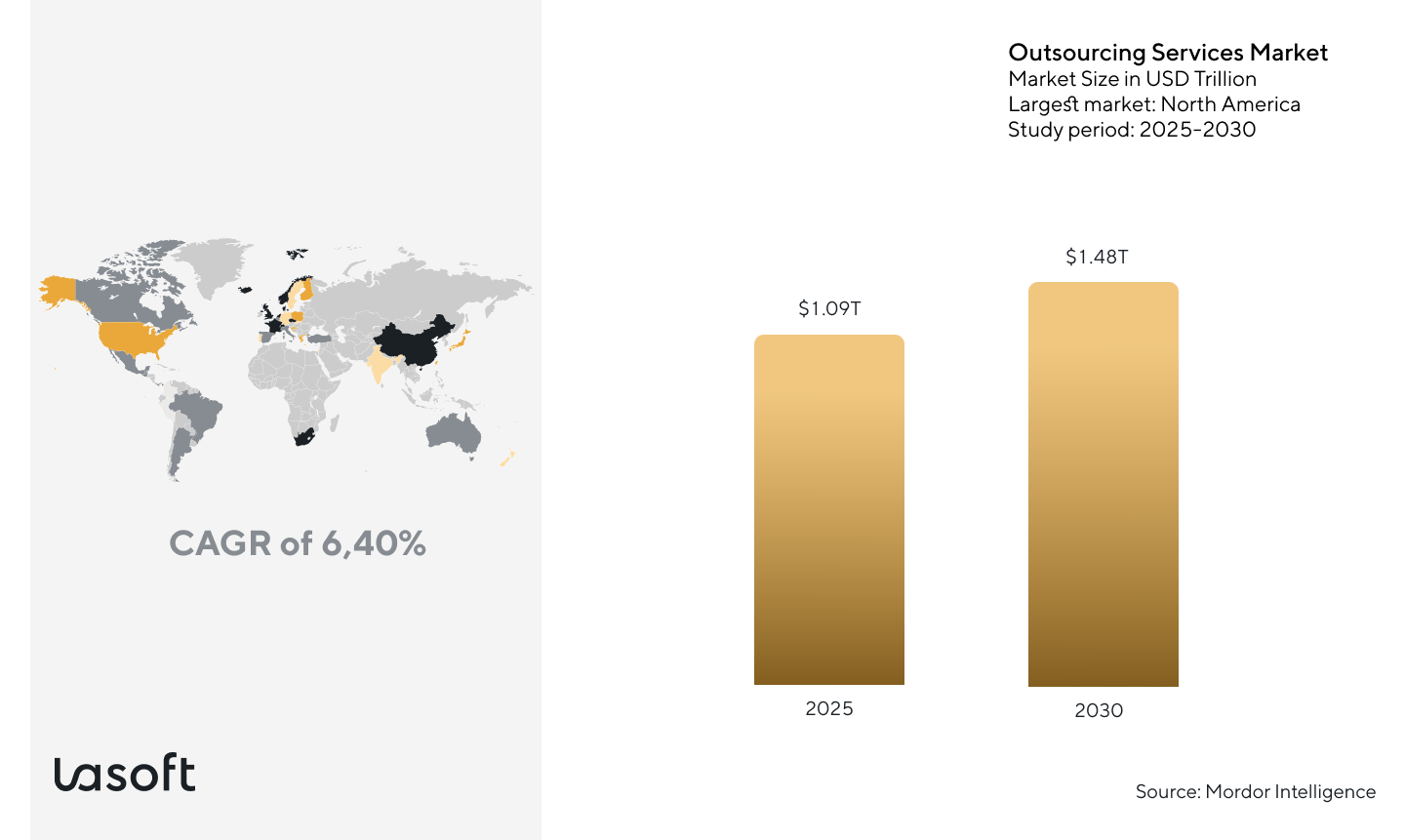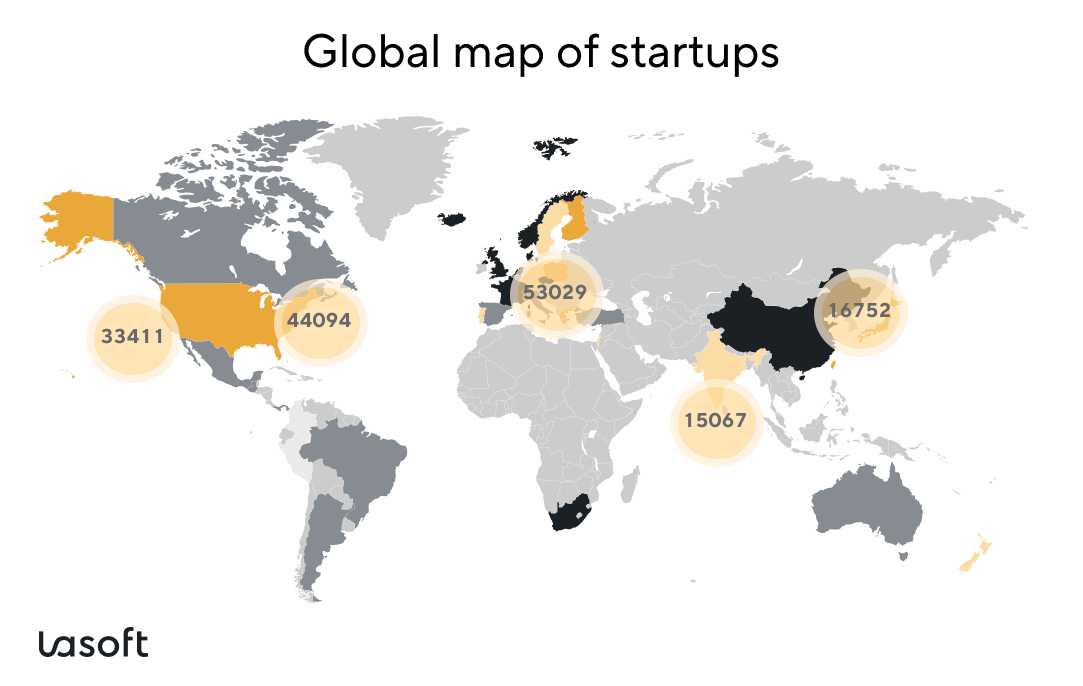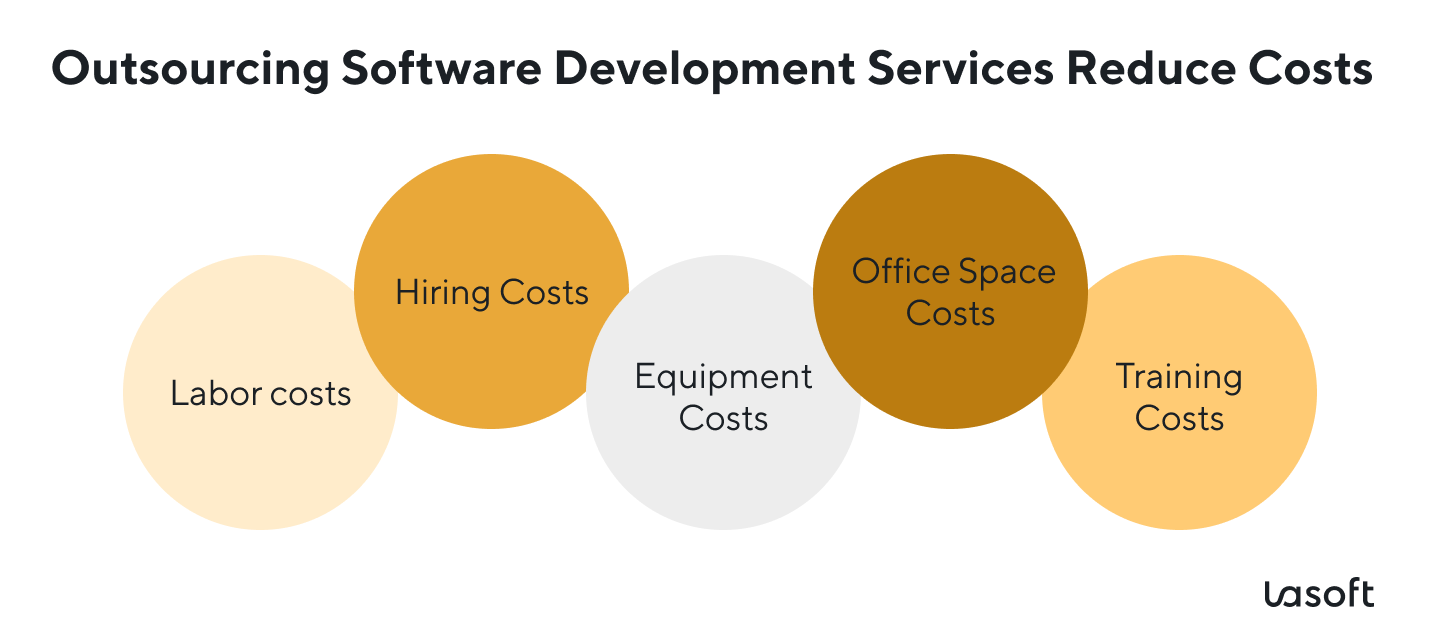If you search for tech experts who can validate your business idea and provide MVP development services before launching a new digital product, or maybe you think of transforming your existing IT infrastructure to automate business workflows. In any case, you’ll find our research and expert opinion valuable to understand the advantages and disadvantages of outsourcing IT.
IT outsourcing involves contracting external vendors to provide IT support that your in-house team can’t manage. Outsourcing teams perform essential services or job functions that may not be within the internal team’s core competencies. The primary concern for managers and business owners is to find an efficient and cost-effective way to manage tech tasks. Commonly outsourced IT functions include cloud maintenance, cybersecurity, tech support, and software product development.
IT Outsourcing Market: Key Insights, Forecasts & Trends
The global IT outsourcing market is projected to reach over $1.00 trillion by 2030, indicating a growth rate (2025-2030) of 6.5% CAGR (source: Mordorintelligence).

The most popular countries for outsourcing services in the software development industry
| Region | Services pros | Popular Countries |
|---|---|---|
| Eastern Europe | High-quality engineering, EU standards, strong English | Ukraine, Poland, Romania, Bulgaria |
| Asia-Pacific | Cost efficiency, huge workforce | India, Philippines, Vietnam |
| Latin America | Good time zone fit for nearshoring to the US | Mexico, Colombia, Argentina |
United States IT Outsourcing Market Analysis
The United States is one of the world’s largest consumers of IT services. It continues to lead the global IT outsourcing market in demand for software development services and the adoption of innovative technologies. Cloud services, cybersecurity expertise, AI/ML integration, digital platform engineering, and business process integration drive the expansion of software outsourcing services. U.S. startups and large enterprises are increasingly looking for third-party providers to reduce costs, accelerate time-to-market, and access the global talent pool.
The US startup ecosystem comprises 7,123 tech companies, and Startupblink has identified 617 unicorns that have surpassed a USD 1 billion valuation.

NOTE: The U.S. information technology sector is experiencing growth:
Over 7 million tech job postings have been recorded, reflecting a 33% month-over-month increase and a 16% rise compared to 2024. (Source: redglobal)
Core Business Drivers Behind Outsourcing Growth
Outsourcing vendors have become key players in many fields, and it’s not just about saving money but also about accelerating AI adoption, providing digital transformation, and validating business ideas to develop digital products that users need.
Global Talent Pool Shortage
You may be surprised to learn that one of the key drivers behind the significant demand for outsourcing in the US is a shortage of skilled professionals. Many companies offer training programs for employees, but these programs are often insufficient. With the rapid pace of technological advancement, the scope of tech skills is shrinking. Roles related to artificial intelligence, especially generative AI, are growing fast.
We researched that companies mostly require software engineers and data scientists who are proficient in building and applying AI models and tools. Industries such as healthcare, retail, HR, martech, telecommunication, insurance, fintech, and education are increasingly seeking professionals with strong expertise in AI, cybersecurity, and dashboard solutions.
Cost Optimization Pressures
With economic uncertainty and inflationary pressures, as well as the instability of the geopolitical situation, cost-saving strategies are more essential than ever on a global scale.
U.S. companies are also under pressure to reduce costs without compromising on innovation or quality. Outsourcing offers a proven path to both cost savings and operational efficiency, cutting IT operating costs by 30–60%, especially in the software development field.
One of the most immediate benefits of collaborating with software development vendors is access to highly skilled professionals in countries with lower wage structures. Hiring a Senior software developer in Eastern Europe or Latin America can cost 40–60% less than hiring domestically in the US.
Moreover, when you choose an outsourcing vendor, you select an out-of-the-box partner who handles all-in-one infrastructure, HR management, and onboarding, thereby eliminating fixed overhead. As a client, you only pay for the work delivered, not for maintaining an internal workforce.
Digital Transformation that Fuels IT Outsourcing Market
These days, businesses of all sizes are racing to modernize their legacy systems to outperform their competitors in the market or at least stay current with emerging technologies, such as AI, cloud computing, and data analytics. But as digital ambitions grow, so does the complexity and cost of execution. That is where IT outsourcing becomes a strategic move.
Digital transformation involves rethinking business models, automating operations, and integrating digital technologies to face several key challenges.
- Customer expectations for seamless experiences;
- Pressure to innovate faster than competitors;
- Need for real-time data, cloud infrastructure, and automation;
- Shortage of skilled IT talent, especially in AI, ML, and DevOps.
These demands put pressure on in-house employees, pushing them to seek a winning solution: one that is quick, flexible, and cost-effective.
How AI & Generative Tools Drive Outsourcing
Artificial Intelligence and generative tools, such as ChatGPT, Claude, and Copilot, are redefining how outsourcing providers deliver value. Traditionally, outsourcing has focused on offering software development and digital transformation services. Now, businesses seek various solutions, such as marketing automation, fraud detection, and real-time data visualization, to enable clients to get answers to their inquiries 24/7 from chatbots or virtual assistants.
It’s as simple as that: businesses are striving to implement AI-powered capabilities to stay competitive. But building these systems in-house presents a serious challenge: the global shortage of AI expertise. As a result, companies are increasingly turning to outsourcing partners to fill the gap and get AI developers, especially those with experience in generative AI. What fosters businesses to seek a provider of outsourcing services?
- AI-powered chatbots and virtual assistants;
- Personalized content and recommendation engines;
- Predictive analytics dashboards;
- AI-enhanced product search;
- Automated customer service solutions.
Developing and integrating these tools requires a unique skill set in machine learning, natural language processing (NLP), and cloud architecture, skills that are in high demand.
Agile Collaboration
These days, companies, especially startups, want to test multiple business models before settling on one. Outsourcing in IT makes it easier to experiment with Minimum Viable Products (MVPs), pilot features, and test markets without incurring long-term commitments or hiring risks.
In times of uncertainty and market fluctuation, businesses must remain agile and able to build a cost-effective strategy for launching new products to the market. Outsourcing companies have the expertise and resources to offer modular and agile team structures.
Access to a Cross-Functional Team
Outsourcing provides companies with access to a cross-functional team of experts who cover the full cycle of software product development. A cross-functional team brings together people with the proper skills and expertise from various tech fields, including Business Analysis, Web Development, UI/UX Design, Quality Assurance, Project Management, and others. These teams focus on the end-to-end development of a product, ensuring that all aspects are covered. By working collaboratively, they leverage the strengths of team members to deliver the best possible outcome.
Outsourcing Advantages and Disadvantages: Navigating the Challenges
From our experience as a software development vendor, we know why outsourcing IT services has become a go-to strategy for startups, SMEs, and large enterprises. Both startups and enterprises need to understand their potential in the market before investing in developing a final product.
As a stakeholder or business owner, you want to test your business idea at the initial stage to communicate your concept to your team, investors, and potential users, thereby raising funds and identifying early adopters in the market. An outsourcing company offers various strategies and tools to help validate your business idea, thereby avoiding failure and financial loss. We encourage you to assess and understand how benefits outweigh the potential disadvantages of an IT outsourcing project and reducing time-to-market for your product.
| Outsourcing pros | Potential drawbacks | |
| 1. Improved Efficiency | Lower labor costs, reduced overhead, and predictable budgets. | Hidden costs if the scope changes or the vendor isn’t well-managed. |
| 2. Access to Global Talent | Immediate access to skilled developers & specialists. | Time zone or communication barriers may slow coordination. |
| 3. Time-to-Market | Agile delivery, MVP development to accelerate delivery timelines. | Quality may vary if the vendor lacks experience or standards. |
| 4. Flexibility & Scalability | Easily scale teams up/down based on project needs. | |
| 5. Access to Latest Tech | Vendors often bring expertise in AI, cloud, and cybersecurity. | Reliance on vendor’s tech stack or decisions. |
| 6. Risk Management | Diversified development reduces dependency on the in-house team. | Data security and compliance risks need careful handling. |
How to Mitigate Potential Risks
Selecting the right IT partner is crucial for successful collaboration. The workflow and stages of cooperation depend on the client’s needs and requirements. An experienced team will advise you on how to assess the outcomes of each sprint.
- Performance metrics to maintain accountability in outsourcing.
- Define quality standards and performance indicators to determine success and enforce accountability.
- Regular reviews of the outcomes are necessary to make sure the team and the client are on the same page and prevent misunderstandings.
- Assess certifications and case studies to gauge their expertise.
- Inquire about responsiveness to support inquiries to measure reliability.
- Check references for valuable insights into their work quality.
Detailed outsourcing contracts support your collaboration to prevent misunderstandings about project scope and deliverables. Unexpected costs can arise from vague contract terms and scope changes. Clearly defining roles, responsibilities, and deliverables in the contract prevents confusion and misalignment.
Internal Resources vs Outsourcing IT Costs
As business owners, IT leaders, or CEOs, you can choose an internal team over an outsourced provider, slightly overlooking hidden costs and additional time and effort, consuming human resources, and diverting your attention from core functions.
Cost-per-Hire: Expenses related to the recruitment process, whether conducted by a recruitment agency or an in-house recruiting team.
Legally Required Benefits: These include sick leave, annual bonuses, overtime pay, training allowances, medical insurance, and other benefits.
Office Infrastructure: This encompasses all costs related to workstations, IT supplies, and licensing fees for software development tools.
Overheads: These are the ongoing expenses required to operate the business.
Taxes: Various taxes that need to be paid as part of employing staff.
We offer you the opportunity to assess whether an in-house development team is a good solution and a competitive advantage for your company’s strategic evolution.

Hiring Expenses
Hiring new employees is expensive, encompassing office setup, equipment costs, and additional overhead expenses such as software licenses and benefits. These costs pile up, significantly impacting your budget. Hiring an in-house team involves significant recruitment expenses, including advertising job openings, conducting interviews, onboarding new employees, setting up an office, purchasing equipment, and acquiring software licenses.
These costs can be substantial, significantly impacting your budget, particularly for specialized IT roles. By delegating these tasks to your outsourced dedicated team, you avoid considerable expenses, saving time and money.
Labor Cost
Reducing costs is a top priority when considering third-party service providers for a software development project. For example, choosing project-based teams over long-term in-house staff cuts expenses. You only incur expenses as tasks progress, and you are not responsible for retaining new employees when new ideas or projects arise.
Additionally, rate variations across countries provide business owners with options to choose the right cooperation practice: onshore, offshore, or nearshore. The trend in the past years shows that Western European countries prefer nearshore outsourcing. You get the team with beneficial options: the same time zone, similar culture, and a high level of education, and you can benefit from lower rates and a nearshore location in Europe.
As employee wages are high in Western Europe and the U.S., outsourcing development can help reduce costs associated with taxes, payroll, bonuses, and employee benefits, such as paid leave, health insurance, and life insurance. Additionally, you do not need to increase your employees’ salaries due to inflation throughout the software development life cycle. A software outsourcing company offers various cooperation models, including the dedicated team model, team extension, and project-based model. It’s up to stakeholders and managers to choose the right model that benefits businesses by leveraging tech skills, advanced technologies, and cost savings.
- AT
- 56599
- BE
- 37200
- BG
- 23729
- HR
- 17056
- CY
- 27000
- CZ
- 35207
- DK
- 70985
- EE
- 38628
- FI
- 48000
- FR
- 43000
- DE
- 62200
- GR
- 16800
- HU
- 24581
- IE
- 56000
- IT
- 30000
- LV
- 30168
- LT
- 37656
- LU
- 62939
- MT
- 35000
- NL
- 61660
- PL
- 33135
- PT
- 20400
- RO
- 19884
- SK
- 27372
- SI
- 26748
- ES
- 32000
- SE
- 44766
- UA
- 30000
Office Space Costs and Equipment
Building an internal team involves more than just salaries; it also entails additional costs, such as office space. More employees mean more offices, whether rented or purchased, which in turn demand extra space and money.
Equipping the team is another expense, as you need to provide your tech staff with tools and laptops. Software development outsourcing companies come fully furnished, eliminating concerns about office space, energy usage, or tool expenses.
Ongoing Training Costs
The in-house team needs to be constantly engaged in training programs, conferences, and team events that align with your company’s values but entail higher costs to retain top talent. Competitive compensation and opportunities for career growth bring employee satisfaction and support a strong team affiliation spirit. All those efforts demand investment in their development, including training expenses. You pay software project outsourcing companies solely on agreed terms, significantly reducing financial obligations.
Final Recap
Overall, outsourcing IT services yields cost savings, access to tech expertise, and an agile approach to client-team collaboration. All the benefits positively affect the company’s culture and reduce overhead costs. Though it’s worth saying that the decision to outsource should not be based solely on price, consider the following:
- How can third-party providers enhance your workflows, business operations, and customer experience?
- How can my external partner help me test my business idea to prove its success in the market?
When done right, outsourcing saves valuable time and fosters a collaborative ecosystem where your idea’s internal strengths are complemented by external expertise and agile collaboration. We shared with you the outsourcing pros and cons. Still, outsourcing enables you to move faster than your competitors, leading to products or services that better meet the business needs and your target audience’s needs.
How about outsourcing your next software project?
At LaSoft, we specialize in AI-enhanced platforms, MVP development, dashboard solutions, custom software development, and more. Let’s talk about how we can support your growth. Just contact our expert.
FAQ
What Services Are U.S. Companies Outsourcing?
- Custom software & app development;
- AI/ML solutions;
- UI/UX design & prototyping;
- Data analytics & visualization dashboards;
- DevOps, QA, and cybersecurity;
- Legacy system modernization, i.e., data transformation.
LaSoft, for example, delivers services across many of these. Our outsourced team offers our expertise in the latest technologies, specializing in infrastructure management, AI-powered platforms, chatbot builders, and business intelligence (BI) tools.
Why should startups consider outsourcing over building an in-house team?
What’s the difference between outsourcing and staff augmentation?
Outsourcing involves delegating entire projects or product development.
Staff augmentation: You hire remote specialists to work under your direct supervision and integrate into your in-house team.
Managed IT services: These services involve a dedicated team model, where a company outsources the entire responsibility for a specific function or process to an external vendor. The service provider manages the work end-to-end, from planning and execution to delivery and maintenance.
Nearshoring: Nearshoring is an outsourcing model in which you partner with companies in nearby countries. It offers the benefits of overlapping time zones and easier travel for on-site visits. Nearshoring combines cost-effectiveness with smoother collaboration. Many companies prefer this type of collaboration as it is convenient and efficient.
LaSoft, for instance, offers various models tailored to client needs.
Can outsourcing cause security problems?
Yes, this model of cooperation is secure if you choose a partner who has positive reviews from clients and has been working in the market for a long period. Most professional outsourcing firms offer:
- Encrypted communication and secure repositories;
- NDA agreements and IP protection;
- Compliance with industry standards like ISO 27001, GDPR, and HIPAA.
Does LaSoft work with US clients?
LaSoft has extensive experience working with clients across the United States. We understand the expectations around communication, time zone coordination, and US business standards.
Our team is well-versed in remote collaboration, with a strong command of the English language, and has extensive experience delivering high-quality software solutions across various industries. We encourage you to check our latest case studies:
US Cyber Insurance (NDA)
NY Insurance Company (NDA)



